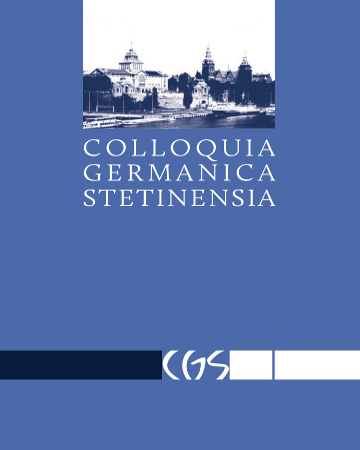







| Autoren: |
Anna
Sulikowska

Wydział Humanistyczny, Instytut Językoznawstwa, US |
| Schlüsselbegriffe: | Polysemie Präposition kognitive Linguistik |
| Data publikacji całości: | 2021 |
| Seitenanzahl: | 21 (91-111) |
| Anzahl der Downloads ?: | 458 |
| 1. | Baldauf, Christa. Metapher und Kognition: Grundlagen einer neuen Theorie der Alltagsmetapher. Frankfurt a. M.: Peter Lang, 1997. |
| 2. | Bączkowska, Anna. „Znaczenia konceptualne przyimków i partykuł angielskich w ujęciu czasoprzestrzeni czterowymiarowej (wstępne założenia metodologiczne)“. Linguistica Bidgostiana 2 (2005): 11–25. |
| 3. | Brenda, Maria. „A cognitive perspective on the semantics of NEAR“. Review of Cognitive Linguistics 15:1 (2017): 121–153. |
| 4. | Brenda, Maria. „The Semantics of AT“, Annales Neophilologiarum 9 (2015): 25–54. |
| 5. | Brugman, Claudia, George Lakoff. „Cognitive topology and lexical networks“. In: Lexical Ambiguity Resolution, hrsg. v. Steven Small, Garrison Cottrell, Michael Tanenhaus, 477–507. San Mateo: Morgan Kaufmann, 1988. |
| 6. | Busse, Dietrich. Semantik. Paderborn: W. Fink, 2009. |
| 7. | Cienki, Alan J. Spatial Cognition and the Semantics of Preposition in English, Polish and Russian. München, Berlin, Washington: Otto Sagner, 1989. |
| 8. | Croft, William. „The role of domains in the interpretation of metaphors and metonymies“ . In: Metaphor and Metonymy in Comparison and in Contrast, hrsg. v. René Dirven, Ralf Pörings, 161–206. Berlin, New York: de Gruyter, 2003. |
| 9. | Drosdowski, Günther, Gerhard Augst. Duden Grammatik der Deutschen Gegenwartssprache. Mannheim: Dudenverlag, 1984. |
| 10. | Evans, Vyvyan, Melanie Green. Cognitive Linguistics. An Introduction. Edinburgh: Edinburgh University Press, 2006. |
| 11. | Evans, Vyvyan. „Prototypes, polysemy and word meaning“. In: The Cognitive Linguistics Reader, hrsg. v. Vyvyan Evans, Benjamin K. Bergen, Jorg Zinken, 127–131. London-Oakville: Equinox, 2007. |
| 12. | Evans, Vyvyan. „From the spatial to the non-spatial: the ‘state’ lexical concepts of in, on and at“ In: Language, cognition and space: the state of the art and new directions, hrsg. v. Vyvyan Evans, Paul A. Chilton, 215–248. London-Oakville: Equinox, 2010. |
| 13. | Grady, Joseph. The Foundations of Meaning: Primary Metaphors and Primary Scenes. Dissertation, Berkeley: University of California, 1997. Zugriff 26.11.2020. https://escholarship.org/uc/item/3g9427m2. |
| 14. | Jackendoff, Ray. Semantics and Cognition. Cambridge: MIT Press, 1983. |
| 15. | Jackendoff, Ray. The architecture of the language faculty. Cambridge: MIT Press, 1997. |
| 16. | Kreitzer, Anatol. „Multiple levels of schematization: A study in the conceptualization of space“. Cognitive Linguistics 8/4 (1997): 291–325. |
| 17. | Lakoff, George. Women, Fire and Dangerous Things: What Categories Reveal about the Mind. Chicago: Chicago University Press, 1987. |
| 18. | Lakoff, George, Mark Johnson. Leben in Metaphern: Konstruktion und Gebrauch von Sprachbildern. Kempten: Kösel, 2000. |
| 19. | Langacker, Ronald. Foundations of Cognitive Grammar. Theoretical Prerequisites. Stanford: Stanford University Press, 1987. |
| 20. | Langacker, Ronald. Cognitive Grammar. A basic introduction. Oxford: Oxford University Press, 2008. |
| 21. | Meex, Birgitte. „Die Wegpräposition über“. In: Perspectives on Prepositions, hrsg. v. Hubert Cuckyens, Günter Radden, 157–176. Berlin: De Gruyter, 2002. |
| 22. | Przybylska, Renata. Polisemia przyimków polskich w świetle semantyki kognitywnej. Kraków: Universitas, 2002. |
| 23. | Tabakowska Elżbieta. „Space and time in Polish: the preposition za and the verbal prefix za-“. In: Motivation in Language. Studies in Honor of Günter Radden, hrsg. v. Hubert Cuyckens, Thomas Berg, René Dirven, Klaus-Uwe Panther, 153–177. Amsterdam, Philadelphia: John Benjamins, 2010. |
| 24. | Tabakowska Elżbieta. „The story of ZA: in defense of the radial category“, Studies in Polish Linguistics 5 (2010): 65–77. |
| 25. | Talmy, Leonard. „How Language Structures Space“. In: Spatial Orientation, Theory, Research, and Application, hrsg. v. Herbert L. Pick, Linda P. Acredolo, 225–282. New York, London: Plenum Press, 1983. |
| 26. | Talmy, Leonard. Toward a Cognitive Semantics, Volumes I and II. Cambridge, Cambridge: MIT Press, 2000. |
| 27. | Tyler, Andrea, Vyvyan Evans. „Reconsidering Prepositional Polysemy Networks: The Case of OVER“. In: The Cognitive Linguistics Reader, hrsg. v. Vyvyan Evans, B. K. Bergen, J. Zinken, 187–238. London, Oakville: Equinox, 2007. |
| 28. | Tyler, Andrea, Vyvyan Evans. The Semantics of English Prepositions: Spatial Scenes, Polysemy, Semantics and the Structure of the Lexicon. New York: Garland Press, 2003. |
| 29. | Vandermeeren, Sonja. „Polysemie bei der Wechselpräposition ,in‘. Eine kognitiv-semantische Untersuchung“. Deutsche Sprache 2 (2004): 171–194. |